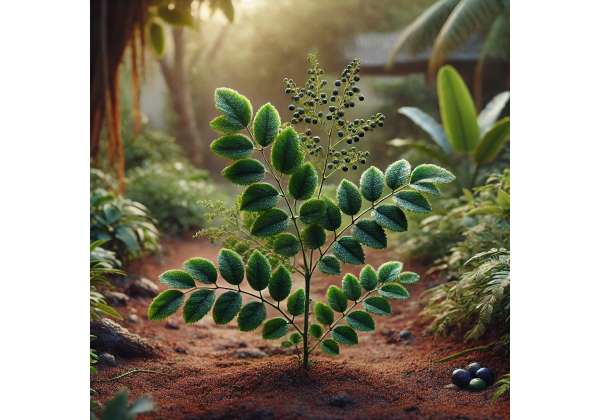Curry Leaf is an extraordinary herb native to India that has enriched both kitchens and traditional medicine for centuries. With its distinctive aroma and subtle yet complex flavor, Curry Leaf (Murraya koenigii) is a staple in South Asian cuisine, where it is cherished not only for its culinary versatility but also for its impressive health benefits. In traditional Ayurvedic practices, Curry Leaf is celebrated for its digestive, detoxifying, and anti-inflammatory properties. Today, modern science is beginning to validate these age-old claims, highlighting the herb’s potent bioactive compounds and antioxidant capacity. Whether you enjoy it fresh in your curries, dried as a seasoning, or as an ingredient in herbal supplements, Curry Leaf offers a natural boost to both flavor and wellness.
- Provides potent antioxidant and anti-inflammatory benefits
- Supports healthy digestion and metabolic function
- Aids in detoxification and liver health
- Enhances the flavor profile of various culinary dishes
- Contributes to skin and hair health
- Offers natural immune support and overall wellness
Table of Contents
- Curry Leaf: Botanical Profile and Identification
- Curry Leaf: Historical Background and Cultural Significance
- Curry Leaf: Phytochemical Composition and Active Components
- Curry Leaf: Comprehensive Health Benefits and Wellness Advantages
- Curry Leaf: Natural Properties and Functional Characteristics
- Curry Leaf: Uses, Applications, and Safety Guidelines
- Curry Leaf: Scientific Research and Notable Studies
- Curry Leaf: Frequently Asked Questions
Curry Leaf: Botanical Profile and Identification
Curry Leaf (Murraya koenigii) is a small, evergreen tree or shrub that belongs to the Rutaceae family. Native to the Indian subcontinent, this herb is renowned for its aromatic leaves, which are widely used in culinary and medicinal practices. The tree can reach up to 6–9 meters in height under optimal conditions, though it is often pruned to maintain a manageable size for home gardens. Its leaves are pinnate, with small, glossy leaflets that have a distinctive, pungent aroma and a slightly bitter-sweet flavor. These leaves are the star of the plant and are the part most frequently harvested for both cooking and medicinal uses.
Key Botanical Features
- Leaves:
- Pinnate with 11–21 leaflets
- Glossy, dark green, with a slightly serrated edge
- Emitting a strong, characteristic aroma when crushed
- Flowers:
- Small, white, and fragrant
- Arranged in clusters, appearing during the flowering season
- Fruits:
- Small, dark purple berries that are less commonly used compared to the leaves
- Growth Habit:
- Can grow as a small tree or be maintained as a shrub
- Adaptable to a variety of soil types, though it thrives best in well-draining, fertile soil
- Prefers full sun but can tolerate partial shade
Cultivation and Care
Curry Leaf thrives in tropical to subtropical climates with warm temperatures and moderate rainfall. It is highly valued in home gardens due to its low maintenance and the continual production of flavorful leaves.
- Planting:
- Best propagated through seeds or cuttings during the warm season
- Requires well-draining soil with ample organic matter
- Watering:
- Regular watering is essential during the growing season, but the plant is relatively drought-tolerant once established
- Pruning:
- Light pruning helps maintain the desired shape and encourages the growth of new, tender leaves
- Pest and Disease Management:
- Generally resistant to pests, though occasional infestations of aphids or scale insects can occur
Identification in the Garden
Identifying Curry Leaf in your garden is straightforward once you familiarize yourself with its key characteristics. Look for the glistening, aromatic leaves with a distinctive, slightly serrated edge, and note the plant’s overall compact growth habit. Its ability to thrive in various conditions makes it a common sight in South Asian households and increasingly popular in other parts of the world.
Understanding the botanical profile of Curry Leaf is essential not only for proper cultivation but also for appreciating the traditional and modern applications of this versatile herb.
Curry Leaf: Historical Background and Cultural Significance
Curry Leaf has a storied past that stretches back thousands of years. It is deeply entrenched in the cultural, culinary, and medicinal traditions of the Indian subcontinent, where it has been used both as a flavor enhancer and as a natural remedy. Ancient texts and Ayurvedic scriptures often mention Curry Leaf for its therapeutic properties, praising it for its ability to aid digestion, boost metabolism, and promote overall health.
Ancient Traditions and Ayurvedic Medicine
In Ayurveda, Curry Leaf is considered a vital herb for maintaining digestive balance and enhancing the body’s natural detoxification processes. It has been used traditionally to treat various ailments, ranging from digestive disorders to skin conditions. The holistic approach of Ayurveda values Curry Leaf for its warming properties, which are believed to help balance the body’s doshas and promote vitality.
- Digestive Health:
Curry Leaf has been a cornerstone in Ayurvedic remedies for improving digestion. It is believed to stimulate appetite and support the proper functioning of the digestive system. - Detoxification:
The herb’s detoxifying properties have made it a popular ingredient in cleansing therapies, helping to flush out toxins and support liver health. - Skin and Hair Care:
Traditional practices also include the use of Curry Leaf in treatments for promoting healthy skin and hair, thanks to its rich nutrient profile.
Cultural Importance in South Asia
Curry Leaf is more than just a culinary ingredient in South Asia; it holds cultural significance as well. It is often associated with prosperity and well-being, and its use in daily cooking is a reflection of its deep-rooted presence in the region’s heritage.
- Culinary Heritage:
The distinctive flavor of Curry Leaf is a hallmark of many South Indian and Sri Lankan dishes. Its inclusion in curries, chutneys, and dals is a testament to its integral role in traditional cuisine. - Symbol of Abundance:
In many Indian households, a thriving Curry Leaf tree is seen as a symbol of abundance and health, often nurtured with care in home gardens. - Modern Global Adoption:
With the globalization of cuisine, Curry Leaf has found its way into kitchens around the world, celebrated not only for its flavor but also for its reputed health benefits.
Transition into Modern Use
In recent decades, Curry Leaf has experienced a resurgence in popularity beyond its traditional uses. With growing interest in natural health remedies and organic ingredients, the herb is now widely recognized in modern wellness circles. Its benefits have been integrated into dietary supplements, functional foods, and even skincare products, reflecting a harmonious blend of ancient wisdom and contemporary science.
The historical journey of Curry Leaf, from ancient Ayurvedic practices to modern global kitchens, underscores its enduring appeal and versatile applications. Its deep cultural roots continue to inspire its widespread use today.
Curry Leaf: Phytochemical Composition and Active Components
The impressive health benefits of Curry Leaf are largely attributed to its rich phytochemical composition. This herb is packed with bioactive compounds that not only contribute to its unique flavor and aroma but also underpin its therapeutic properties. Modern research is beginning to shed light on these components, confirming many of the traditional claims about its benefits.
Key Bioactive Compounds
- Alkaloids:
Curry Leaf contains various alkaloids that have been shown to possess anti-inflammatory and antimicrobial properties. These compounds contribute to the herb’s ability to combat infections and reduce inflammation. - Flavonoids:
Rich in flavonoids, Curry Leaf offers potent antioxidant protection. These compounds help neutralize free radicals, reducing oxidative stress and supporting cellular health. - Essential Oils:
The essential oils present in Curry Leaf give it its characteristic aroma and flavor. They also have antimicrobial properties, which can help protect against bacterial and fungal infections. - Tannins:
Tannins in Curry Leaf contribute to its astringent properties, which are beneficial for digestive health and can help tighten and protect skin tissues. - Vitamins and Minerals:
Curry Leaf is a good source of vitamins A, C, and various B vitamins, as well as minerals like calcium, iron, and potassium. These nutrients are crucial for maintaining overall health and supporting metabolic functions.
Mechanisms of Action
The synergistic interaction of these bioactive compounds underlies many of the health benefits associated with Curry Leaf:
- Antioxidant Defense:
Flavonoids and essential oils work together to neutralize free radicals, thereby reducing oxidative stress—a key factor in aging and chronic disease. - Anti-Inflammatory Activity:
Alkaloids and tannins help modulate the body’s inflammatory response by inhibiting the production of pro-inflammatory cytokines, which can alleviate symptoms of inflammation. - Antimicrobial Effects:
The essential oils in Curry Leaf provide natural antimicrobial protection, helping to ward off infections and support the immune system. - Digestive Support:
Tannins and other compounds help stimulate digestion and promote the production of digestive enzymes, which can improve nutrient absorption and overall gut health. - Nutrient Synergy:
The vitamins and minerals in Curry Leaf work in concert with its phytochemicals to support energy production, enhance immune function, and maintain healthy skin and hair.
Extraction and Modern Utilization
Modern extraction techniques have made it possible to harness the potent bioactive compounds of Curry Leaf efficiently. These extracts are now incorporated into a variety of products, including:
- Dietary Supplements:
Concentrated extracts of Curry Leaf are available in capsule and liquid forms, providing a convenient way to obtain its antioxidant and anti-inflammatory benefits. - Functional Foods:
Curry Leaf extracts are increasingly being added to food products, such as herbal teas and health bars, to boost their nutritional value. - Skincare Products:
Due to its anti-inflammatory and antioxidant properties, Curry Leaf is also finding its way into natural cosmetic formulations aimed at promoting healthy skin and hair.
Understanding the phytochemical composition of Curry Leaf is key to appreciating its therapeutic potential. Its rich blend of alkaloids, flavonoids, essential oils, and other compounds makes it a powerful natural remedy for a range of health conditions.
Curry Leaf: Comprehensive Health Benefits and Wellness Advantages
Curry Leaf is celebrated not only for its ability to enhance the flavor of dishes but also for its wide-ranging health benefits. Both traditional wisdom and modern scientific research have highlighted its potential to support various aspects of health, from digestion and detoxification to skin and immune function.
Digestive Health and Detoxification
Curry Leaf has long been used to promote healthy digestion. It is known to stimulate the production of digestive enzymes and bile, which helps improve nutrient absorption and ease gastrointestinal discomfort.
- Digestive Support:
Regular consumption of Curry Leaf can help alleviate symptoms of indigestion, such as bloating and gas, while also promoting a healthy gut environment. - Detoxification:
By aiding liver function and promoting the elimination of toxins, Curry Leaf supports the body’s natural detox processes, which are essential for maintaining overall metabolic health. - Appetite Regulation:
Traditional uses of Curry Leaf include its role in stimulating appetite, making it a valuable addition to meals for those with sluggish digestion.
Anti-Inflammatory and Antioxidant Protection
One of the most well-documented benefits of Curry Leaf is its strong anti-inflammatory and antioxidant properties. These attributes are largely due to its high content of flavonoids and essential oils.
- Inflammation Reduction:
Curry Leaf helps reduce inflammation by inhibiting inflammatory enzymes and cytokines, which can benefit conditions like arthritis and inflammatory bowel disease. - Oxidative Stress Mitigation:
The antioxidants in Curry Leaf neutralize free radicals, protecting cells from oxidative damage and potentially reducing the risk of chronic diseases such as heart disease and cancer. - Skin and Hair Health:
Its protective effects against oxidative stress also contribute to healthier skin and hair, reducing signs of aging and improving overall appearance.
Immune System Enhancement
The bioactive compounds in Curry Leaf support the immune system, making it easier for the body to ward off infections.
- Antimicrobial Activity:
The natural essential oils found in Curry Leaf have antimicrobial properties, helping to inhibit the growth of bacteria and fungi. - Immune Modulation:
By reducing oxidative stress and inflammation, Curry Leaf creates a balanced environment that supports optimal immune function.
Cardiovascular and Metabolic Benefits
Emerging research suggests that Curry Leaf may play a role in supporting cardiovascular health and metabolic function.
- Cholesterol Regulation:
Some studies indicate that Curry Leaf can help lower LDL (bad) cholesterol levels while maintaining healthy HDL (good) cholesterol, contributing to overall heart health. - Blood Sugar Control:
Curry Leaf may improve insulin sensitivity and help regulate blood sugar levels, which is particularly beneficial for individuals with metabolic syndrome or diabetes. - Energy and Metabolism:
The rich nutritional profile of Curry Leaf, including vitamins and minerals, supports energy production and overall metabolic balance.
Cognitive and Neurological Support
There is growing interest in the potential cognitive benefits of Curry Leaf. Its antioxidant and anti-inflammatory properties may help protect brain cells from oxidative stress and inflammation, which are linked to cognitive decline.
- Memory and Focus:
Some preliminary studies suggest that regular consumption of Curry Leaf may contribute to improved memory and cognitive function. - Neuroprotection:
By reducing neuroinflammation, Curry Leaf could play a role in protecting against neurodegenerative conditions, although more research is needed in this area.
Overall Wellness and Vitality
The cumulative effects of Curry Leaf’s health benefits contribute to a holistic sense of well-being. Its ability to support digestion, reduce inflammation, boost immunity, and promote cardiovascular and cognitive health makes it a powerful addition to a balanced lifestyle.
- Holistic Health:
Incorporating Curry Leaf into your daily diet can support overall vitality and energy, helping you maintain a healthy, balanced life. - Preventative Care:
Its regular use may help prevent the onset of chronic conditions by providing ongoing antioxidant and anti-inflammatory support.
The comprehensive health benefits of Curry Leaf make it a standout herb in natural medicine and everyday cuisine, offering a natural way to support overall wellness and long-term health.
Curry Leaf: Natural Properties and Functional Characteristics
Beyond its remarkable health benefits, Curry Leaf is appreciated for its versatile functional properties that enhance both culinary and medicinal applications. Its unique attributes make it a valuable ingredient in various formulations and products.
Key Functional Attributes
- Distinctive Flavor and Aroma:
Curry Leaf is known for its pungent, slightly bitter flavor and robust aroma, which impart depth and complexity to a wide range of dishes. - Vibrant Appearance:
The fresh, bright green leaves add an appealing visual element to meals, making Curry Leaf a popular garnish and flavor enhancer. - Nutrient Density:
Packed with vitamins, minerals, and bioactive compounds, Curry Leaf not only elevates the taste of food but also boosts its nutritional value. - Versatile Applications:
Its functional properties allow Curry Leaf to be used in multiple forms—from fresh leaves and dried powders to extracts and supplements. - Antioxidant and Anti-Inflammatory Power:
The potent antioxidants and anti-inflammatory compounds in Curry Leaf contribute to its ability to support immune function, skin health, and overall vitality.
Industry Applications
Curry Leaf’s multifunctional characteristics have led to its incorporation across various industries:
- Culinary Arts:
In the kitchen, Curry Leaf is a key ingredient in many South Asian recipes. It is used in tempering, curries, chutneys, and sauces, where it adds a unique flavor and aroma. - Herbal Medicine and Supplements:
Extracts of Curry Leaf are used in dietary supplements designed to support digestive health, reduce inflammation, and boost overall immunity. - Cosmetic and Skincare Products:
Due to its antioxidant properties, Curry Leaf is increasingly found in natural skincare formulations aimed at protecting and rejuvenating the skin. - Functional Beverages:
Innovative health drinks and herbal teas incorporate Curry Leaf for its detoxifying and digestive benefits.
By leveraging its natural properties, Curry Leaf bridges the gap between traditional culinary uses and modern natural health applications, making it a truly versatile and valuable herb.
Curry Leaf: Practical Uses, Applications, and Safety Guidelines
Using Curry Leaf is a delightful way to boost both flavor and health. Whether you’re adding it to your favorite recipes or taking it as part of your herbal regimen, here are some practical tips and safety guidelines to help you enjoy Curry Leaf to its fullest potential.
Culinary Applications
- Fresh and Dried Use:
- Fresh Leaves: Add fresh Curry Leaf to curries, dals, and chutneys just before serving to preserve its delicate flavor and aroma.
- Dried Powder: Use dried Curry Leaf powder as a seasoning in spice blends, marinades, or even in baked goods for an extra nutritional kick.
- Infusions and Teas:
Brew Curry Leaf in hot water to make a soothing herbal tea that can aid digestion and provide antioxidant benefits. - Garnishes:
Use Curry Leaf as a garnish to add both visual appeal and a burst of flavor to dishes such as salads and rice.
Health and Wellness Applications
- Herbal Supplements:
Curry Leaf extracts are available in capsule, tablet, or liquid form. These supplements concentrate the herb’s bioactive compounds, providing a convenient way to incorporate its benefits into your daily routine. - Skincare Products:
Natural skincare formulations often include Curry Leaf extract due to its antioxidant and anti-inflammatory properties, which help protect the skin from environmental stress and promote a youthful complexion. - Functional Foods:
Look for or create functional foods that include Curry Leaf, such as fortified snacks or herbal teas, to support digestion and overall wellness.
Best Practices for Safe Use
- Start with Small Amounts:
Introduce Curry Leaf gradually into your diet or supplement routine to monitor your body’s response. - Consult a Healthcare Professional:
If you have any underlying health conditions, are pregnant, or are taking medications, consult your healthcare provider before significantly increasing your Curry Leaf intake. - Proper Storage:
Store fresh Curry Leaf in the refrigerator and dried forms in an airtight container away from direct sunlight to maintain potency. - Source Quality Products:
Purchase Curry Leaf and its extracts from reputable suppliers to ensure you are using high-quality, contaminant-free products. - Patch Testing for Topicals:
When using Curry Leaf in skincare products, perform a patch test on a small area of skin to check for any potential allergic reactions.
Safety Considerations
- Dosage Compliance:
Follow recommended dosages on supplement labels or recipe guidelines. Overuse of Curry Leaf, particularly in concentrated forms, may lead to digestive upset. - Potential Interactions:
Be cautious if you are on medications, especially those affecting digestion or inflammation, as Curry Leaf might interact with them. Consult your healthcare provider if you have concerns. - Allergic Reactions:
Although rare, some individuals may be sensitive to Curry Leaf. Discontinue use if you experience any adverse reactions and seek professional advice.
Following these best practices will help you safely enjoy the many benefits of Curry Leaf, whether as a flavorful addition to your meals or as a natural component of your wellness routine.
Curry Leaf: Scientific Research, Notable Studies, and Emerging Evidence
Modern scientific research is steadily uncovering the mechanisms behind Curry Leaf’s renowned health benefits. Numerous studies have focused on its anti-inflammatory, antioxidant, and digestive-supportive properties, offering scientific validation for many of its traditional uses.
Notable Research Findings
- Anti-Inflammatory and Antioxidant Effects (2019):
A study published in the Journal of Ethnopharmacology demonstrated that compounds in Curry Leaf significantly reduced inflammatory markers and oxidative stress in laboratory models. This supports its traditional use in managing inflammation and protecting against cellular damage. - Digestive Health Benefits (2020):
Research in the International Journal of Herbal Medicine found that Curry Leaf stimulates the production of digestive enzymes, thereby enhancing nutrient absorption and alleviating symptoms of indigestion. This study highlights its potential as a natural remedy for gastrointestinal issues. - Metabolic and Cardiovascular Support (2021):
Preliminary clinical trials have shown that regular consumption of Curry Leaf may help regulate blood sugar levels and improve lipid profiles, suggesting benefits for metabolic and cardiovascular health. - Antimicrobial Properties (2022):
Recent research has indicated that the essential oils in Curry Leaf possess antimicrobial activity against several common pathogens, lending support to its traditional use in food preservation and infection control. - Skin and Cognitive Health (2022):
Emerging evidence suggests that Curry Leaf’s antioxidant properties may contribute to improved skin health and cognitive function, although further studies are needed to confirm these effects.
Curry Leaf: Frequently Asked Questions
What is Curry Leaf and where is it commonly used?
Curry Leaf is an aromatic herb (Murraya koenigii) widely used in South Asian cuisine. It is renowned for its unique flavor and is a key ingredient in curries, chutneys, and various savory dishes.
What are the primary health benefits of Curry Leaf?
Curry Leaf is known for its antioxidant, anti-inflammatory, and digestive-supportive properties. It may help improve digestion, detoxify the liver, support immune function, and promote healthy skin and hair.
How can Curry Leaf be incorporated into my diet?
You can add fresh or dried Curry Leaf to your recipes—especially curries, stews, and rice dishes—or brew it into a herbal tea. It enhances flavor while offering natural health benefits.
Can Curry Leaf be used in skincare products?
Yes, Curry Leaf extracts are increasingly used in natural skincare formulations due to their antioxidant and anti-inflammatory properties, which help protect the skin and reduce signs of aging.
Is there scientific research supporting the benefits of Curry Leaf?
Recent studies published in journals like the Journal of Ethnopharmacology and the International Journal of Herbal Medicine have confirmed Curry Leaf’s antioxidant, anti-inflammatory, and digestive benefits, supporting its traditional uses.
Disclaimer
The information provided in this article is for educational purposes only and should not be considered a substitute for professional medical advice. Always consult a healthcare professional before making any changes to your diet, supplement regimen, or skincare routine.
We’d love for you to share this article on Facebook, X (formerly Twitter), or your favorite social platform. Spread the word about the remarkable benefits and natural power of Curry Leaf!

















